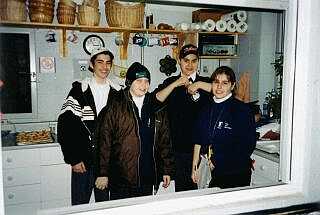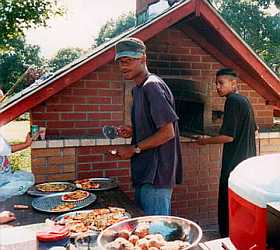


On this page:
Related pages:
- The Zamboni Kitchen
- On June 17 2003, Dufferin Grove Park got funding to put a kitchen into the last available unused space in the park's rinkhouse/ clubhouse. Here is the report we had to submit at the end of the project. [There was surprising drama during the building of the kitchen: the Blackout, and the Inspector Crisis] Read more >>
- Our Community Bake Ovens
- When we first put out feelers in 1995 to see if anything would stop us from building a communal wood-fired oven, we found to our amazement that there was nothing to stop us. Read more >>
- Recipes
- Some recipes to add to your index card box. Read more >>
- Picnics
- Having a picnic in the park. Read more >>
Our Zamboni Café

In the rinkhouse
Zamboni Café
The Zamboni Café is open during skating season only. In spring, summer, and early fall, park food is available from the community bake ovens (on pizza days, Friday night suppers, and some special events) or from the food cart.

Cooking food in the bake oven
Food Cart
When the city of Toronto was forced, by provincial edict, to amalgamate with its neighbouring municipalities in 1997, the city councillors gave out a few last-minute grants as they were clearing their desks. The "Friends of Dufferin Grove Park" got a surprise cheque for a proposal that had been previously rejected: to develop a prototype of a street-food cart that would be both cheap for a handyman to build and easy to keep sanitary for serving food. Commercial food carts used by the city's licensed hot dog vendors are entirely made of stainless steel and very expensive. But Toronto is full of people from other countries who have street food experience but little capital to get started. We wanted to know: is there a cheaper version of a safe food cart? Now, start-up costs are not the only problems facing street food vendors. They also have no legal permission to sell anything other than hot dogs in public space. Ontario law says hot dogs are the only "food substance" that's safe to sell from street carts.
Common sense suggests that calling hot dogs a safe food is a stretch. Given a choice, many citizens would pick a different dinner. And they can buy whatever they like, a great variety of prepared foods, at restaurants or in the deli sections of food stores. But as long as the hot dog law is in force, people strolling along the street, or sitting on a park bench, will be deprived of the different foods that can be made in the open air.
Under the restriction of such a narrow law, how can the gifts of ordinary street-food cooks get a chance to manifest themselves? The answer, in Toronto, is connected with outdoor festivals. Because Toronto is so diverse in its people, and because our city councillors long ago made provisions for allowing ethnic festivals of all kinds, at these festivals the rule of hot dogs has given way. Citizens have seen and tasted for themselves what a wonderful range of foods can come from a food cart grill, and how ingenious the cooking arrangements can be when variation is permitted.
When the festivals are over, street food reverts to hot dogs. But the cat is out of the bag: we know there's something missing. The riddle is, how to get the missing gifts of ordinary people - in this case, of street-food cooks, some of them new to the city and without much money - out into public space.
 In order to figure out this riddle, one has to experiment. Yet when our laws prescribe precisely how the world must be, it's hard to try new things. Still, what choice do we have? So in our park we asked Alan Carlisle, a carpenter who likes to solve problems, to take the city's unexpected grant and fiddle around with bits of scrap plywood (cheap), sheets of stainless steel (sanitary when kept clean), and bicycle wheels. I had been part of an Ontario government investigation into food regulations a few years before, as an interested "consumer," so I had some idea of the rules, and their rationale. Alan and I put our heads together, and he went to work in the rink house garage. The cart Alan built cost under $1000, counting stainless steel insert, water bottle, refrigeration chests, umbrella, and cooking equipment. At that time the cost of a commercial stainless steel cart was around $6000.
In order to figure out this riddle, one has to experiment. Yet when our laws prescribe precisely how the world must be, it's hard to try new things. Still, what choice do we have? So in our park we asked Alan Carlisle, a carpenter who likes to solve problems, to take the city's unexpected grant and fiddle around with bits of scrap plywood (cheap), sheets of stainless steel (sanitary when kept clean), and bicycle wheels. I had been part of an Ontario government investigation into food regulations a few years before, as an interested "consumer," so I had some idea of the rules, and their rationale. Alan and I put our heads together, and he went to work in the rink house garage. The cart Alan built cost under $1000, counting stainless steel insert, water bottle, refrigeration chests, umbrella, and cooking equipment. At that time the cost of a commercial stainless steel cart was around $6000.
We began to use our new cart at festivals and within the park. Because most of us are amateurs at selling food, some of our efforts were clean but ungraceful. Making food under the open sky, without a house at your back, presents some tricky problems.
Street food cooks of all kinds have developed simple solutions, worked out over time. Their food had to look tasty, and it had to be clean. Presumably an old-time food seller who made her customers sick, lost a lot of her customers, one or two through (maybe fatal) illness, and the rest through word-of-mouth: "don't go to her, she'll make you sick." So there must have always been an incentive to be safe. But when there is a long break in street food selling, some important details will be forgotten. That's dangerous. So now if we want to put good food back into outdoor public space like streets and parks, we have to be smart and careful, and invent the most fitting arrangements for us.
The stakes are high, but so are the rewards: to have another channel for the gifts of a multiplicity of good cooks, allowing them to make a living and enliven their neighbourhoods at the same time.
Which brings us back to our park. One wonderful thing about a public park is that the people who own the park - i.e. everyone - can try things on a small scale. Another wonderful thing is that there are no walls, so anyone can see these experiments, and can give their opinion, and then go on and tell other people what they saw. The park food cart is then a public experiment.
In 2003 we began to try running a summertime organic food cart. (With some success, and a bit of backsliding.) This coming summer we'll try again, a little more ambitiously. The puzzle is: can food-cart vendors make such beautiful vegetable dishes that our legislators will have to change the laws protecting hot dogs from any competition? We welcome participation in solving this puzzle.